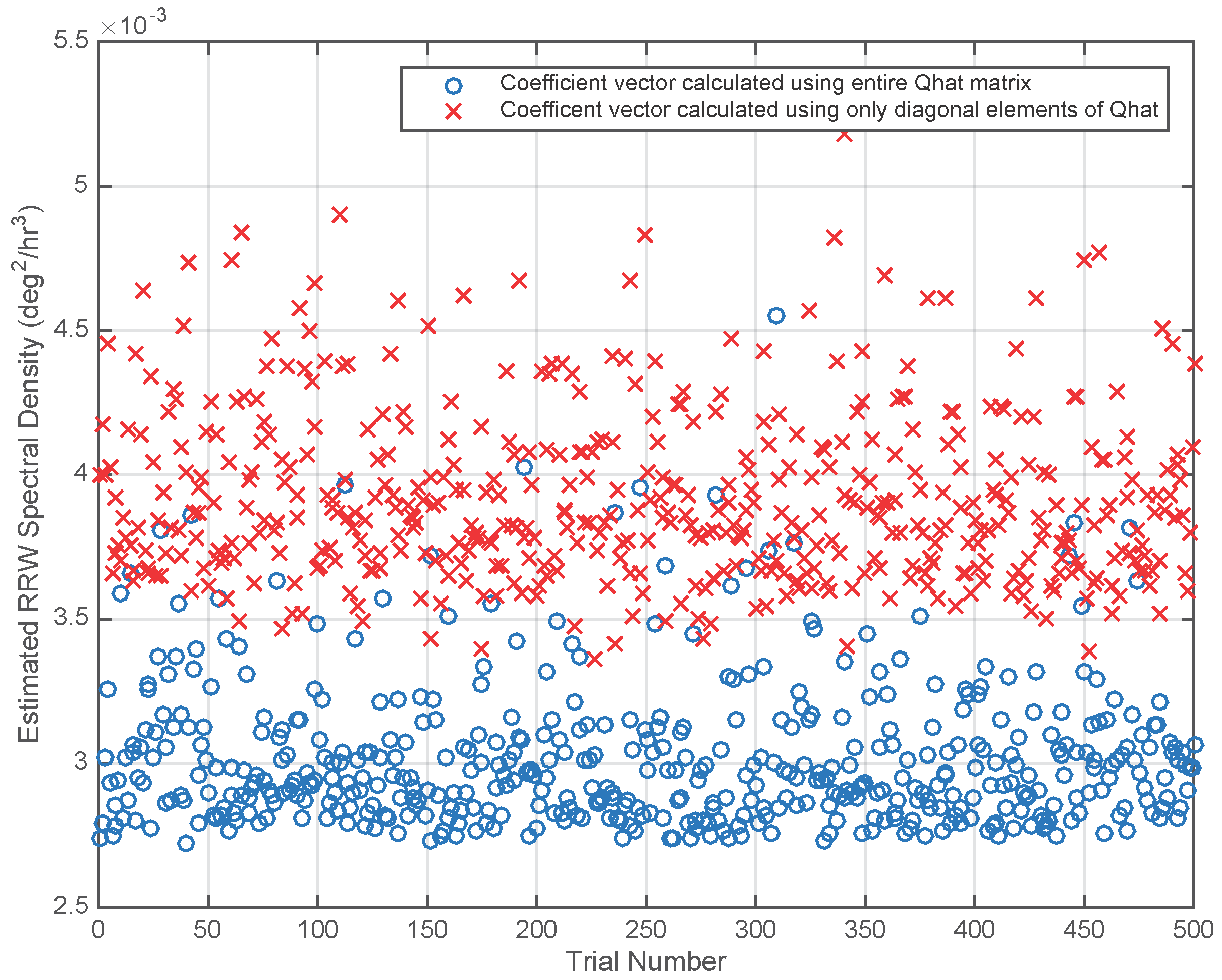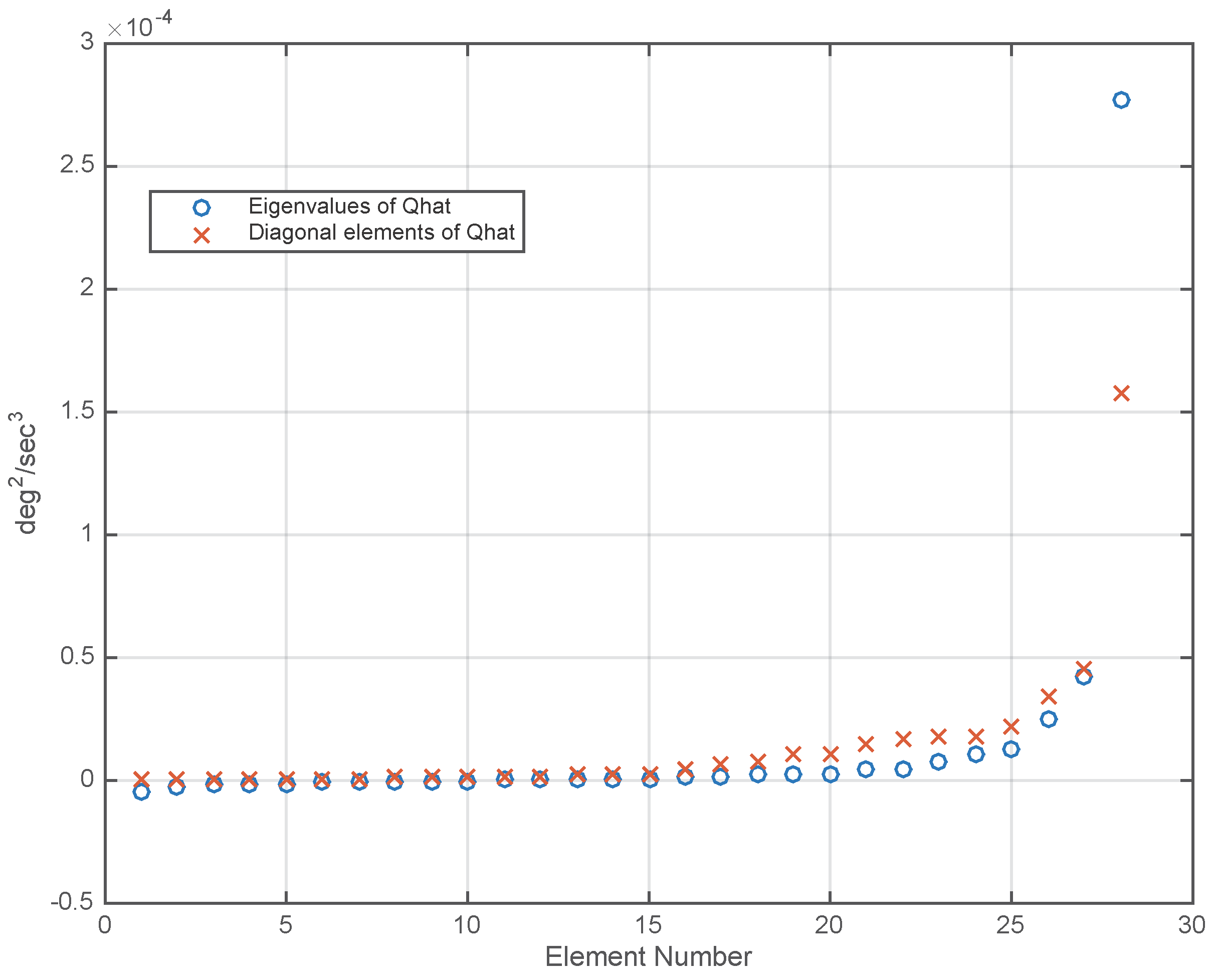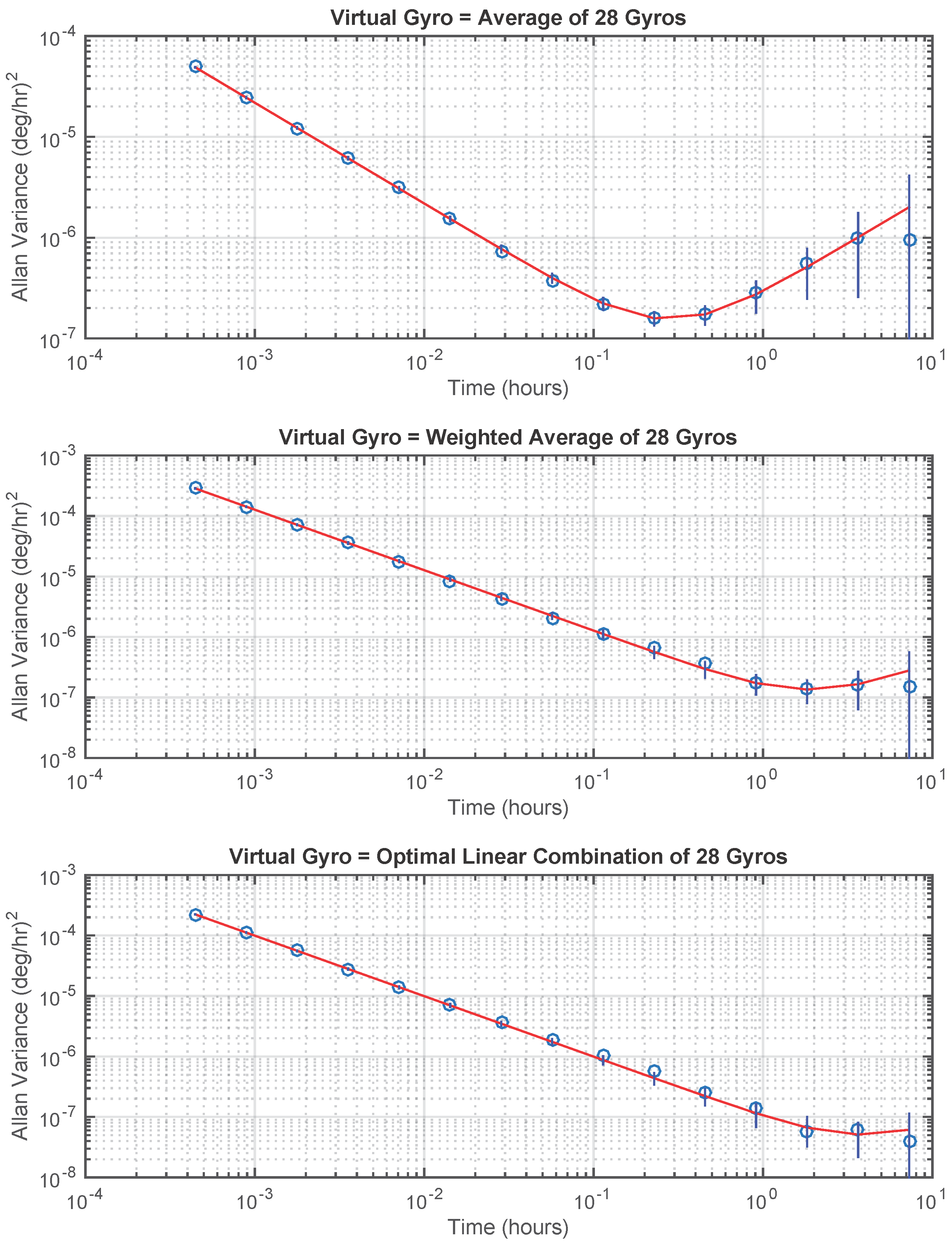Reduced-Drift Virtual Gyro from an Array of Low-Cost Gyros
Abstract
:1. Introduction
2. Results
2.1. Single-Gyro Model for Noise and Drift
2.2. Mean and Covariance
2.3. Algorithm for Estimating Q and R for a Single Gyro
| Algorithm 1: An algorithm for estimating individual gyro parameters Q and R. ©2012 IEEE, reprinted with permission from [10]. | |
| 1. | Given a data record of N points of gyro calibration data let , where is the integer part of . Calculate the Allan variance statistic for . |
| 2. | Let be an estimate of the smoothing lag corresponding to the minimum value of the Allan variance. For example, choose to be the index from Step 1 that gives the smallest Allan variance. |
| 3. | From the values of m calculated in Step 1, select , such that the maximum value satisfies . |
| 4. | Obtain a preliminary estimate of R |
| 5. | Calculate a preliminary estimate of Q:
|
| 6. | Let (see Equations (13) and (14)):
|
| 7. | The estimates of Q and R are given by
|
2.4. Mathematical Model for a Two-Gyro Array
2.5. Mean of the Allan Covariance
2.6. Covariance of the Allan Covariance
2.7. Statistical Model for a Gyro Array
| Algorithm 2: An algorithm for estimating the off-diagonal terms, , of the spectral density matrix for the drift components of an array of gyros. | |
| 1. | Given a data record of N points of vector-valued gyro calibration data from an array of g gyros, let , where is the integer part of . Calculate the set of Allan covariance matrices using Equations (21) through (23) for all , where . |
| 2. | Estimate the individual gyro statistics and , using the algorithm for single gyros given in Algorithm 1. |
| 3. | Let be the vector whose elements are for all . |
| 4. | Let
|
| 5. | Calculate the covariance matrix (see Equations (37) and (38))
|
| 6. | The estimate of is calculated as follows:
|
2.8. Optimal Linear Combination of Gyro Signals
2.9. Simulation Example
Theoretical Calculations
2.10. Simulation Results
2.11. Hardware Results for a 28-Gyro Array
3. Discussion and Conclusions
Author Contributions
Conflicts of Interest
Appendix A. Derivation of Covariance of Allan Covariance Between Two Gyros
References
- Bayard, D.S.; Ploen, S.R. Foundations of Virtual Gyroscope Synthesis; Jet Propulsion Laboratory Internal Document, JPL-D-21656; Jet Propulsion Laboratory: Pasadena, CA, USA, 2002. [Google Scholar]
- Bayard, D.S.; Ploen, S.R. High Accuracy Inertial Sensors From Inexpensive Components. U.S. Patent 6,882,964 B2, 19 April 2005. [Google Scholar]
- Chang, H.; Xue, L.; Qin, W.; Yuan, G.; Yuan, W. An integrated MEMS gyroscope array with higher accuracy output. Sensors 2008, 8, 2886–2899. [Google Scholar] [CrossRef] [PubMed]
- Totu, L.; Koldbaek, S.K. Improving MEMS Gyroscope Performance Using Homogeneous Sensor Fusion. Master’s Thesis, Department of Electronic Systems, Aalborg University, Aalborg, Denmark, 2011. [Google Scholar]
- Chang, H.; Xue, L.; Jiang, C.; Kraft, M.; Yuan, W. Combining Numerous Uncorrelated MEMS Gyroscopes for Accuracy Improvement Based on an Optimal Kalman Filter. IEEE Trans. Instrum. Meas. 2012, 61, 3084–3093. [Google Scholar] [CrossRef]
- Mallik, H.; Jyothi, D.; Varma, M.; Rao, D.; Agrawal, V.K. Minimum Variance Optimal Filter Design for a 3 × 3 Gyroscope Cluster Configuration. In Proceedings of the Fourth International Conference on Advances in Control and Optimization of Dynamical Systems, Tiruchirappalli, India, 1–5 February 2016; Volume 49, pp. 639–645.
- IEEE Standard Specification Format Guide and Test Procedure for Single-Axis Interferometric Fiber Optic Gyros; IEEE Std. 952-1997; IEEE: Piscataway, NJ, USA, 1998.
- Ford, J.J.; Evans, M.E. Online estimation of Allan variance parameters. J. Guid. Control Dyn. 2000, 23, 980–987. [Google Scholar] [CrossRef]
- Vaccaro, R.J.; Zaki, A.S. Statistical Modeling of Rate Gyros and Accelerometers. In Proceedings of the 2012 IEEE/ION Position, Location and Navigation Symposium (PLANS 2012), Myrtle Beach, SC, USA, 23–26 April 2012.
- Vaccaro, R.J.; Zaki, A.S. Statistical Modeling of Rate Gyros. IEEE Trans. Instrum. Meas. 2012, 61, 673–684. [Google Scholar] [CrossRef]
- El-Sheimy, N.; Hou, H.; Niu, X. Analysis and modeling of inertial sensors using Allan variance. IEEE Trans. Instrum. Meas. 2008, 57, 140–149. [Google Scholar] [CrossRef]
- Guerrier, S.; Molinari, R.; Stebler, Y. Theoretical Limitations of Allan Variance-based Regression for Time Series Model Estimation. IEEE Signal Process. Lett. 2016, 23, 595–599. [Google Scholar] [CrossRef]
- Li, J.; Fang, J. Sliding Average Allan Variance for Inertial Sensor Stochastic Error Analysis. IEEE Trans. Instrum. Meas. 2013, 65, 3291–3300. [Google Scholar] [CrossRef]
- Guerrier, S.; Skaloud, J.; Stebler, Y.; Victoria-Feser, M. Wavelet-Variance-Based Estimation for Composite Stochastic Processes. J. Am. Stat. Assoc. 2013, 108, 1021–1030. [Google Scholar] [CrossRef] [PubMed]
- Stebler, Y.; Guerrier, S.; Skaloud, J.; Victoria-Feser, M. Generalized Method of Wavelet Moments for Inertial Navigation Filter Design. IEEE Trans. Aerosp. Electron. Syst. 2014, 50, 2269–2283. [Google Scholar] [CrossRef]
- Yuan, D.; Ma, X.; Shang, Z.; Yan, S. Statistical Modeling of Random Walk Errors for Triaxial Rate Gyros. IEEE Trans. Instrum. Meas. 2016, 65, 286–296. [Google Scholar] [CrossRef]
- Kay, S. Fundamentals of Statistical Signal Processing: Estimation Theory; Prentice-Hall: Englewood Cliffs, NJ, USA, 1993. [Google Scholar]
- Colomina, I.; Gimenez, M.; Rosales, J.J.; Wis, M.; Gómez, A.; Miguelsanz, P. Redundant IMUs for Precise Trajectory Determination. In Proceedings of the XXth ISPRS Congress, Istanbul, Turkey, 12–23 July 2004. ISPRS Archives Volume XXXV, Part B1.
- Janssen, P.H.M.; Stoica, P. On the expectation of the product of four matrix-valued Gaussian random variables. IEEE Trans. Autom. Control 1988, 33, 867–870. [Google Scholar] [CrossRef]
- Bendat, J.S.; Piersol, A.G. Random Data Analysis and Measurement Procedures, 4th ed.; John Wiley & Sons: Hoboken, NJ, USA, 2010. [Google Scholar]



| Method 1 | Method 2 | Method 3 | |
|---|---|---|---|
| Coefficient Vector | |||
| Method | ARW | RRW |
|---|---|---|
| 1 | ||
| 2 | ||
| 3 |
© 2017 by the authors. Licensee MDPI, Basel, Switzerland. This article is an open access article distributed under the terms and conditions of the Creative Commons Attribution (CC BY) license ( http://creativecommons.org/licenses/by/4.0/).
Share and Cite
Vaccaro, R.J.; Zaki, A.S. Reduced-Drift Virtual Gyro from an Array of Low-Cost Gyros. Sensors 2017, 17, 352. https://doi.org/10.3390/s17020352
Vaccaro RJ, Zaki AS. Reduced-Drift Virtual Gyro from an Array of Low-Cost Gyros. Sensors. 2017; 17(2):352. https://doi.org/10.3390/s17020352
Chicago/Turabian StyleVaccaro, Richard J., and Ahmed S. Zaki. 2017. "Reduced-Drift Virtual Gyro from an Array of Low-Cost Gyros" Sensors 17, no. 2: 352. https://doi.org/10.3390/s17020352






